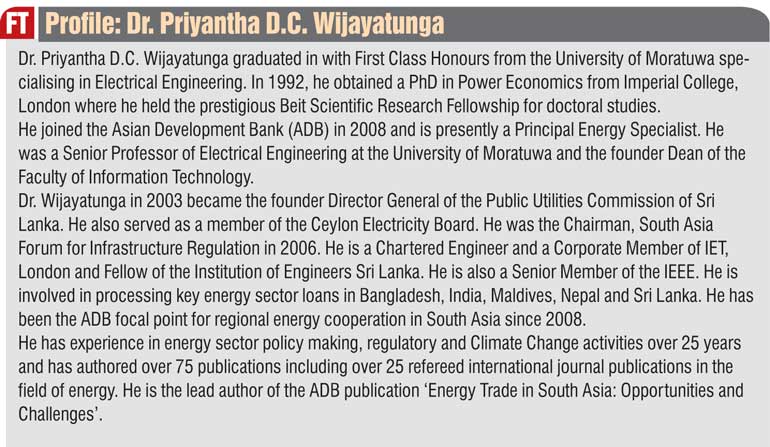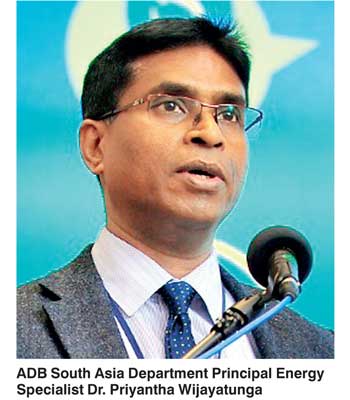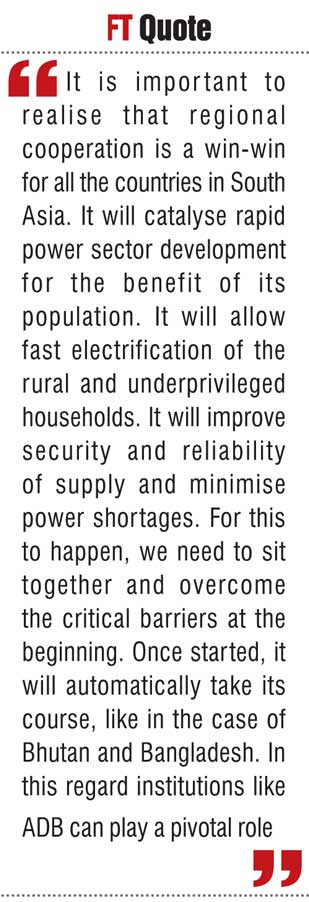Monday Dec 29, 2025
Monday Dec 29, 2025
Wednesday, 28 October 2015 00:00 - - {{hitsCtrl.values.hits}}

Following is the Eng. D.J. Wimalasurendra Memorial Lecture 2015 delivered by Asian Development Bank South Asia Department Principal Energy Specialist Dr. Priyantha Wijayatunga on ‘Regional Cooperation for Clean Energy Development, Increased Electricity Access and Enhanced Supply Security’

Large hydropower development in Sri Lanka pioneered by Eng D.J. Wimalasurendra has helped Sri Lanka to start a long journey on the use of indigenous primary energy sources for electricity generation. This journey filled with many hurdles as well as numerous achievements has led the country to supply almost 100% of its power requirements with hydropower by 1990s.
With the rapidly increasing demand and the maximum large hydropower potential being gradually reached, Sri Lanka turned to other primary sources of energy to fulfil its generation requirements. However, the contribution of hydropower in the overall power generation equation in Sri Lanka still remains critical.
This hydropower development initiated in 1920s with the first plant coming to operation in 1950, has helped the country in many ways. It has largely contributed to rapid expansion of the country-wide household electrification well beyond those of our neighbours. This includes the expansion of the national grid into rural areas and providing connections to the underprivileged households. Also it has saved enormous amount of foreign exchange over the last 65 years. Even today, these hydropower plants help the Ceylon Electricity Board to bring down the average cost of electricity supply and to minimise the losses it incurs in selling electricity at a subsidised tariff.
We can examine the clean power generation development in the South Asia region in the same manner as we look at the hydropower development in Sri Lanka. South Asia is sitting on large hydropower resources and other clean energy sources such as wind power, solar power and biomass. For instance South Asia has an estimated 294,000MW of economically exploitable hydropower potential contributed by 150,000MW in India, 45,000MW in Pakistan, 42,000MW in Nepal and 30,000MW in Bhutan. In addition, the neighbouring regions such as Central and West Asia region and East Asia region also have large hydropower resources. All these three regions have large coal and natural gas reserves too. However, only a fraction of these clean energy sources has been developed for the benefit of the region. 
For instance, Nepal’s hydropower development is less than 800MW while Bhutan’s is less than 2000MW and India’s is around 40,000MW. The development of wind power has been significant during the last 10 years or so mainly due to the rapid development in India. Development of solar power and biomass is still picking up, again dominated by India’s national solar mission declared a few years ago. This means there is a huge potential for clean energy development in South Asia alone.
Even with these opportunities of generation development, South Asia is still suffering from low household electrification rate with more than 350 million people still without access to electricity even for their basic needs such as lighting. Even those having access to electricity suffer from poor quality of supply with regular interruptions and poor voltage levels. A majority of countries in the region suffer from daily and seasonal power shortages due to lack of generation capacity and transmission bottlenecks. It is quite ironic that a region blessed with so much of clean energy has to go through these power issues, particularly in countries where there are adequate resources within their own boundaries.
In order to address these issues, we need to rapidly add more generation capacity and expand the transmission and distribution systems. This needs to be carried out at the least cost and with a minimum impact on the environment, if the countries in the region to get the maximum benefit from such development. For this purpose it is important to create and environment conducive for both public and private sector investment since the investment requirement will be enormous.
How can regional cooperation help?
How can regional cooperation help in this scenario? First and foremost is the market size. Regional cooperation will allow any financier of infrastructure to look at the regional market as a whole, rather than individual countries. This means, naturally a larger market with a bigger diversity of customers. This will allow financiers to minimise risks in their investments and hence the total investment cost will be minimised.
The second is the opportunity to share experience and expertise. Individual countries in the region has years of experience in specific areas of power sector development in many ways. For instance, Sri Lanka has a done a lot in small hydropower development, Bangladesh in solar home systems, India in wind power and solar power development. Over the years these countries have developed their own expertise in these specific areas. These experiences and expertise can be shared as a region which would help again to minimise technology risks and the cost of deploying these clean energy solutions.
As we know the demand for electricity will continue to grow exponentially in the region for many years to come. Large part of this demand is planned to be met by increased fossil fuel based generation. This is particularly significant in India where plan is to add about 60,000MW of thermal power plants during the next 5 years. Regional cooperation in energy can result in more interconnections and power trading with countries like Bhutan and Nepal where the hydropower development potential is enormous. Such power trading will undoubtedly lead to less fossil fuel use, or deferment of the development of fossil fuel based plants in the region. This means less environmental emissions, having both local and global impacts. Another advantage regionally interconnected power system has is the reduced reserve generation capacity requirement compared to isolated individual systems. This means, reduced cost of electricity supply to the consumers which is eventually reflected in the form of reduced consumer tariffs. Then comes the reliability of supply. Naturally an interconnected system has a better ability cope up with sudden disturbances in the power system compared to those isolated country power systems.
The most important gain in regional cooperation with an interconnected power system is the ability to reduce the power deficits in the region within a minimum period of time. This is by exploiting idling generation in the region resulting from transmission constraints or higher generation costs, and exploiting the differences in the consumption patterns, for the benefit of those consumers who can be served in another part of the region. At the moment, you may not believe, India has a significant level of idling generation capacity without takers. Interestingly, at the same time, India experiences power shortages. Bangladesh and Nepal crave for more supplies to fulfill their demand. Also the demand patterns tend to be different in different parts of the region during the day and different seasons of the year. This means the generation capacity can be shared among different parts of the region which obviously lead to lowering costs.
Trading power
Let us look at, again, specifically our own region. What can we do in the form of infrastructure development related regional energy cooperation? Between India and Nepal, we can develop large scale transmission interconnections which can carry power towards Nepal in the short and medium term to reduce power deficits in Nepal.
It is already happening today at a lower scale with Nepal importing about 100-150MW of generation from India through small capacity interconnections at the border for islanded systems within Nepal. In the longer term Nepal can develop its hydropower capacity in large volumes keeping in mind the Indian market. This will attract more investors at reduced development costs. Nepal and India can also develop their transmission interconnections and in-country networks for such large scale power evacuation.
The interconnections can be either in synchronous mode, which means AC-AC interconnections initially, like the ongoing construction of the first large scale 1000MW transmission line from Dhalkebar in Nepal to Muzzafarpur in India. Later as the power flows increase probably some these interconnections may have to be high voltage DC lines.
In the case of power transfers between Bangladesh and India, probably it is likely to be Bangladesh importing power from India most of the time. Bangladesh power sector is presently heavily dominated by the domestic natural gas based power plants. These gas resources are fast depleting while the demand for electricity in Bangladesh is exponentially increasing.
The fastest way to bridge the gap is to construct transmission interconnections with India and import power. The first ever grid-to-grid interconnection in South Asia commissioned between Bangladesh and India in 2013 as a high voltage DC line of 500MW funded by Asian Development Bank. In the times to come, Bangladesh might even export power to West Bengal at certain times of the day or year, if their plans for large scale coal and LNG based power plants materialise.
The other major possibility is the power transmission lines from the hydropower and gas rich North-Eastern region of India to Northern India through Bangladesh with Bangladesh benefiting from some power tapped off for its own use and from power transmission wheeling charges. The bilateral discussions today revolves around a 6000MW transmission interconnection with about 2000MW tapped off for Bangladesh use. These interconnections are also likely to be DC interconnections to ensure that individual country systems can be independently operated.
Bhutan has been trading power with India for some time with its large hydropower resources are being gradually developed and the transmission interconnections being strengthened. So much so, today Bhutan boasts of the third highest per capita income in South Asia with almost half of its GDP coming from power sales to India. Bhutan is executing 10000MW hydropower development program with the assistance of India and some of the largest hydropower projects in South Asia are under construction at present in Bhutan.
The required transmission strengthening across the border is also progressing. Also it is important to note that these hydropower plants in Bhutan (and even in Nepal for that matter) are run-of-the river plants with almost no storage. During the winter the river flows come down to as low as 20% of the peak time flows. This means Bhutan imports power from India during these periods.
Despite the political sensitivities, interconnections between Pakistan and India are also possibilities. In fact an interconnection of 250MW/500MW capacity has been flagged in recent times between Pakistan and India. Because of the severe power shortages in Pakistan this will have to be an interconnection importing power from India at the beginning. In addition, the interconnections between Pakistan and Afghanistan which allows large power transfers from hydropower rich Central Asia to South Asia is also on the table and is being seriously pursued.
The interconnection between Maldives and the rest of South Asia is distant possibility at this stage considering that it requires long submarine cables which cannot be economically and financially justified. Maldives is a small Island nation with only 350,000 people and a generation capacity requirement of only less than 300MW in total including tourist resorts.
India and Sri Lanka
A transmission interconnection between India and Sri Lanka has been discussed since 1970s when we thought we can export power to India with the completion of the Mahaweli Project. Lately these discussions have been revived partly with the support of Asian Development Bank since 2006 to examine the possibility of a 500/1000MW interconnection for power exchange between India and Sri Lanka. Such an interconnection will provide access to the Indian power market which will expand opportunities for power producers from Sri Lanka, particularly those involved in clean energy development. Even for conventional power plants such an interconnection opens opportunities to earn extra revenue when the plants are idling or part loaded.
We have conducted a study to examine the economic benefits of six interconnections which are seriously considered for implementation. In fact some of these interconnections are already in place or under construction. The study clearly shows that the economic benefits of interconnections far outweigh the cost of constructing them. Of course, how these economic benefits are shared between the respective countries is left to the negotiations between relevant parties. What is important is that these are win-win situations for the countries concerned.
Overcoming barriers
In order to make regional cooperation in the energy sector to work, we need to overcome certain barriers. We need to overcome policy and regulatory barriers, build required cross-border transmission infrastructure and improve mutual understanding among the policy makers, regulators, utilities and even investors in respective countries. We need to have regional power cooperation and trade recognised in policies, laws and regulations and the necessary provisions in these areas need to be put in place. We need to discuss and agree on a common set of regulations, grid codes, transmission plans and dispute resolution mechanisms relating to cross-border assets and trade.
However, what is most important is that we have already got regional groupings where we can discuss these barriers and come to agreements to overcome them. Some of them are SAARC Energy Working Group, South Asia Subregional Economic Cooperation (SASEC) Energy Working Group, South Asian Forum for Infrastructure Regulators (SAFIR) and SASEC Transmission Utility Forum (SETUF). We have many intergovernmental and bilateral meetings where we can discuss these matters and come to agreements.
Supporting regional cooperation is a key component of Asian Development Bank Strategy 2020. The core emphasis is in energy, transport and trade facilitation sectors. Our emphasis in the energy sector is to have a fully interconnected transmission system to facilitate rapid development of the clean power generation. This will allow a development of a vibrant regional power market and also opens up opportunities for knowledge and experience sharing.
As in the case of South Asia we are also supporting similar efforts in Central Asia, and Greater Mekong Subregion. In South Asia, ADB financed the SAARC Regional Energy Trade Study (SRETS) and South Asia Regional Power Exchange Study (SARPES). Both these documents have been tabled in related SAARC meetings and have been endorsed. These are the documents on which most of the assistance on regional cooperation is now provided. Development of a cross-border transmission plan is also underway with ADB assistance. We supported setting up of the SASEC Electricity Transmission Utility Forum (SETUF) and its present operations. In fact Sri Lanka is the current chair of SETUF and we are planning to have the 3rd meeting in Colombo in the third week of October.
ADB financed the export-oriented Dagachchu and Nakachchu projects in Bhutan and in the process of preparing the Dudh Koshi hydropower project in Nepal for ADB financing. We have been strengthening the in-country transmission network in all the countries which also support possible cross-border transfers. The feasibility study of the second cross-border line between India and Nepal is ongoing with ADB assistance. ADB also supports some activities relating to India-Sri Lanka transmission interconnection.
In conclusion it is important to realise that regional cooperation is a win-win for all the countries in South Asia. It will catalyse rapid power sector development for the benefit of its population. It will allow fast electrification of the rural and underprivileged households. It will improve security and reliability of supply and minimise power shortages. For this to happen, we need to sit together and overcome the critical barriers at the beginning. Once started, it will automatically take its course, like in the case of Bhutan and Bangladesh. In this regard institutions like ADB can play a pivotal role.